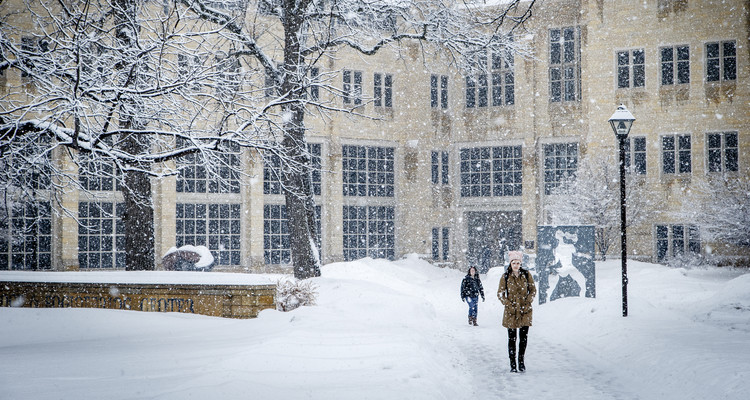Dear St. Thomas faculty and staff,
Extremely cold temperatures and heavy snowfalls characterize winters in Minnesota and can lead to dangerous and unsafe conditions. The university leadership is concerned for the safety of students, staff and faculty when these conditions arise. Snow, cold and ice can create situations where the university may cancel classes or close entirely. In addition, emergencies of other kinds (i.e., tornadoes, electrical outages, water outages, chemical spills, etc.) also can result in class cancellation or the university’s closure.
Decision to cancel classes or close the university:
The university’s executive vice president and provost is the university official responsible for canceling classes, suspending operations or closing the university. Individual colleges and schools and other business units do not close unless the university is closed. The provost makes the decision after appropriate consultation with the university president and other internal and external parties.
Class Cancellation:
- The university remains open and operational when classes are cancelled. An alert is sent through the Emergency Notification System (USTALERT) and emails sent to St. Thomas accounts.
- University offices remain open during their normal business hours when classes are cancelled. Employees, including student employees, still are required to report to work as scheduled, unless they use paid leave time approved by their supervisors.
- If an event or activity is scheduled when classes are canceled, the event planner is responsible for deciding whether the event or activity will be held and communicating the status to constituents. If the event or activity is canceled, the event planner must notify the external parties and St. Thomas operational staff.
University Closure:
- When the university is closed, classes are canceled and all offices are closed. The duration can vary. Watch for an alert through the Emergency Notification System and an email to your St. Thomas account.
- Anderson Student Center, Anderson Athletic and Recreation Center and the O’Shaughnessy-Frey Library remain open until 8 p.m. unless otherwise specified.
- Employees not designated as “emergency essential employees” are excused from work, without a change in compensation, for the duration of the closure.
- During a closure, emergency-essential employees are expected to report to work and/or remain at work for the duration of their scheduled shift unless otherwise notified. These employees include, but are not limited to, Public Safety personnel, certain employees from Facilities Management, ITS, O’Shaughnessy-Frey Library and Food Services.
Events and activities when the university is closed:
- The executive vice president and provost will decide which, if any, special events on campus are considered essential, including, but not limited to, weddings, funerals, rentals of university property and catering activities. Event coordinators and their support employees are then considered essential and should report for work.
- The athletics director will determine if on-campus athletics events will be canceled after appropriate consultation with internal and external parties, including the Minnesota Intercollegiate Athletic Conference.
- Non-essential events or activities will not be held if the university is closed, and event coordinators should communicate event cancellations to attendees.
Timing of a decision cancel classes or close the university:
If the university cancels classes or closes, every effort is made to provide adequate notice. A class cancellation or closure for the day will be announced by 6 a.m. if possible. If the university cancels classes or closes mid-day, a decision will be made by noon. If the weather or situation subsides as the day progresses, evening classes and events may resume as scheduled, and a new notification will be issued by 4 p.m.
Employee compensation during a university closure:
| Employee Type | Work from home during closure? | Paid during closure? | Rate of Pay |
| Faculty (Exempt/Salaried) | Encouraged | Yes | Regular base (or per contract for Adjuncts) |
| Exempt/Salaried Staff | Encouraged | Yes | Regular base |
| Non-Exempt/Hourly Staff | No | Yes | Regular hourly |
| Emergency Essential Non-Exempt/Hourly Employees | No | Yes | Double time |
| Non-emergency essential asked to come in for coverage | No | Yes | Exempt: Regular base
Non-Exempt: Double time |
| Unionized employees | No | Per contract | Per contract |
| Scheduled Student Workers | No | Yes | Regular hourly |
| Unscheduled Student Workers | No | No | N/A |
Regular hourly staff whose positions are designated “emergency essential” receive pay for hours actually worked the day of the emergency closing in addition to their regular pay for all scheduled work hours that day. If you have a question as to your “emergency essential” status, please contact your department supervisor.
Hourly “emergency essential” employees should record their actual hours worked on their timesheets and record normally scheduled hours as “excused days.” For example: The employee was scheduled to work from 7:30 a.m. to 4 p.m. The university announces a closure, and the employee actually works from 7:30 a.m. to 11:30 a.m. This employee would record four hours worked on the timesheet and record eight hours as “excused days” for a total of 12 hours paid at the regular rate. Hourly emergency essential employees in Facilities Management should record time worked by logging in and out at the time clock system.
Sincerely,
Richard Plumb, Ph.D.
Executive Vice President and Provost







